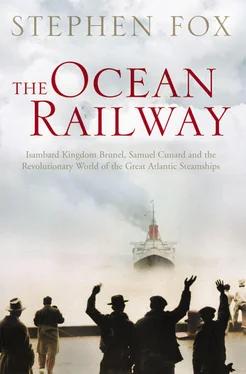In iceberg season, with visibility more crucial than ever, the Grand Banks fogs throw a dense, smothering blanket over the ice field. The wind dies down. The sea is lumpy and tumbling. Warning bells and foghorns are muffled, distorted, their direction and distance rendered unknowable. Both sight and hearing become untrustworthy. A constant condensing rain drips from the ship’s superstructure. Shapes take ongigantic, unnatural proportions. A bird may resemble a sail. Ghosts and mirages float by. Peering hopelessly through the thick white smoke, a lookout can mistake an iceberg for a ship, or ship for iceberg. The circumstances are gloomy, anxious, strange and very dangerous.
The great circle route runs along the Newfoundland coast, with its rocky headlands and variable currents driving now towards shore, then out to sea. ‘ The uncertaintyrequires the greatest caution,’ John Purdy warned in 1817. Farther west, about a hundred miles off Nova Scotia, lurks Sable Islandand its shifting shoals and sandbars. Moving steadily eastward, sometimes at a mile every four years (and therefore impossible to chart precisely), and often invisible in fog, Sable has sunk many ships. The fog can then persist all the way down the American coast to Boston and New York.
By the nineteenth century, through various accidents of history, this most dangerous sea passage had also become the most trafficked long ocean route in the world. The burgeoning imperatives of trade, empire and human migration between the hemispheres would not give way, even to the North Atlantic Ocean in winter. Some reliable means of making this roughest transatlantic crossing – in all seasons, and in reasonable speed, safety, comfort and economy – had to be devised. It posed a fundamental challenge to the newly inventive, progressive spirit of the age.
The first enduring steamship service between England and America began when the wooden paddle wheeler Britannia,of the new Cunard Line, left Liverpool for Halifax and Boston on 4 July 1840. With Samuel Cunard, founder of the line, on board, the Britannialaboured across the ocean against head winds and adverse currents. Ten days out, an iceberg was sighted in the near distance: a reminder of the North Atlantic’s perils. The ship was scheduled to depart from Liverpool a few days before the fourth, and she was therefore expected in Boston by the fourteenth. When that day passed without the Britannia,people in Boston started worrying. A steamship was supposed to make faster, more reliable ocean passages than a sailing ship; that was the whole point of adding the steam engine and paddles.
Four days went by amid swelling anxieties. Finally, at ten o’clock on the night of Saturday, the eighteenth, the Britannia glided into Boston Harbor. Despite the late hour she was greeted by fireworks and huzzahs – and a general sense of relief. She had made the passage in fourteen and a half days, just one-third of the time consumed by the most recent sailing packet from England to Boston. On Sunday, Sam Cunard received eighteen hundred invitations to dinner. ‘ No eventwhich has occurred since the commencement of the present century,’ the Reverend Ezra Gannett told his prominent congregation that morning, ‘seems to me to have involved more important consequences to this city.’
The man and his ship dominated Boston for the next two weeks. Thousands of people came to inspect the Britannia at the new Cunard wharf; Bostonians had never seen such a ship. At the time, a typical coasting steamboat was about 160 feet long and 400 tons, a typical ocean-sailing packet about 150 feet and 700 tons. (In nautical idiom, a ‘ton’ measured not weight or displacement but interior space, calculated in different ways but, in 1840, supposed to equal forty cubic feet.) The Britannia was much bigger than contemporary ship norms at 207 feet and 1156 tons, with steam power in due proportion. She had been built of African oak and yellow pine at Robert Duncan’s shipyard on the River Clyde; the celebrated Robert Napier of Glasgow had provided her 403-horsepower engine. From a distance she looked like a quite large sailing ship, dominated by three masts and sails in conventional riggings. But at midship two black-and-gold paddle boxes extended almost twelve feet out to each side, with a single smokestack just aft, painted burnt-red with a black ring at the top: a future signature of Cunard ships. The Britannia was, properly speaking, neither steamship nor sailing ship but a hybrid of the two.
Much of the main deck was left flat and clear to give the crew unobstructed room for handling sails and rigging. Deckhouses at midship provided quarters for the officers, sailors, and the ship’s cows. A raised, exposed bridge between the paddle boxes and above the deckhouses allowed the captain and his adjutants the sight lines and free access they needed to run the ship. (Years later, after paddle wheels had yielded to screw propellers for propulsion, the term ‘bridge’ remained to designate where a steamship’s officers stood and gave orders.) Aft of the mainmast, another deckhouse held the passengers’ dining saloon, the largest room on the ship at thirty-six feet by fourteen feet; it also functioned as a sitting room and assembly hall. At the stern, a raised platform gave the helmsman and his wheel a quite wet, windy place from which to steer the ship.
From the saloon, stairs descended to the gentlemen’s and ladies’ cabins and lounges. Men and women were consigned to separate sections, linked by a passage that allowed decorous contact without risking the weather up on deck. A typical ‘stateroom’ measured about twelve by six feet, tightly packed with two bunk beds, jugs and basins for washing and emergencies, a small mirror on the wall, a water carafe and glasses, a day sofa, and pegs for hanging clothes. A porthole or oil lamp provided dim light. ‘ All these roomsare highly finished,’ a Bostonian noted, ‘without any attempt to dazzle with tinsel.’ The undersides of the cabin floors were covered with a thick, coarse woollen cloth intended to seal off smells and heat from the holds and engine room. Passengers – the ship had room for up to one hundred men and twenty-four women, all in a single class – shared a few water closets and had no bathing facilities at all.
The provision deck below held quarters for the engineers and firemen. They fed and tended the engine, the rhythmically beating heart of the ship. The machinery and coal bunkers at midship took up a third of the Britannia’s length, leaving relatively little space for cargo on such an enormous vessel. The firemen shovelled coal into twelve furnaces firing four boilers feeding steam to the engine. Still brand-new, the engine and its moving parts shone like burnished silver. Two cylinders, six feet in diameter, drove nineteen-foot levers to turn the paddle wheel crankshaft. At full steam the paddles, nine feet wide and twenty-eight feet in diameter, could push the ship up to almost nine knots.
To a greater degree than anything previously seen in Boston, the Britannia was a ship and a building and a machine, all at once, on the grandest and most daring scale. One dazzled observer called her ‘ the consummationof human ingenuity’, no less. She seemed to vault beyond the usual construction categories, gathering them into a novel kind of manmade artefact. Large, plush and inventive, utterly modern but oddly familiar, beautiful from her soaring masts down to her gleaming engine room and yet promising such great practical significance, she left admirers in Boston mingling their superlatives. ‘ She is trulya magnificent vessel, ’ the Evening Journal declared, ‘ – a floating palace.’
Three days after Samuel Cunard’s arrival, Boston threw a grand party for him attended by nearly 2000 people. The toasts were so extended, the speeches so hyperbolic even by the rhetorical standards of the time, that it seems apparent that more than just a man and his ship was being celebrated. The Cunard Line was largely a British enterprise, based in Liverpool and launched by a mail contract from the British Admiralty. The first Cunard ship was pointedly named the Britannia, and she was commanded by Captain Henry Woodruff of the Royal Navy, not a civilian. In the previous sixty-five years, Britain and America had fought two bitter wars against each other and then had engaged in constant mutual insults and fierce squabbles over Canadian independence, boundaries and fishing rights. Only a year earlier, the American state of Maine andthe Canadian province of New Brunswick had nearly started a war. Now the Cunard Line inspired new hopes for friendlier ties between mother country and wayward child. In addition, Boston by 1840 was losing its former commercial and maritime eminence to New York; but both cities had competed for the glittering prize of becoming Cunard’s American terminus, and Boston had apparently won. This coup perhaps augured a general resurgence for the city against its bumptious rival down on the Hudson. And, finally, that summer the United States was torn by an especially rancorous presidential contest, the log cabin and hard cider campaign of William Henry Harrison against the incumbent Martin Van Buren. With the Britannia on hand, at least, Boston’s feuding Whigs and Democrats might briefly unite behind a promising new venture of general benefit.
Читать дальше












